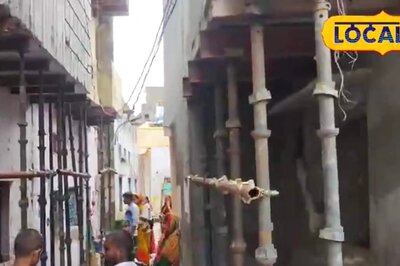
views
BANGALORE: In Bangalore it’s not uncommon to see Hindu deities residing in odd places like the middle of the road or under a Peepal tree near a bus stop. If lucky, the gods have a shelter if not, they have to make do with a stone slab balanced on two stone pillars above the idol. They are sure to have vermilion powder on their forehead, half-burnt camphor, flowers and other articles that indicate a religious ritual or pooja had taken place.The other usual abodes of the Gods are magnificent architectural beauties that inspire devotion merely by sight. The elaborate towers and temple walls narrate mythological stories that take imaginations that once were confined to our minds and give them physical shape. Then there are those obscure ones that are neither easily accessible nor beautified but more powerful. The Gods seem to be hidden as if they don’t wish to be disturbed. Only those whose devotion can overcome obstacles are worthy to see the divine and offer prayers.The last category of temples is as mystical as it is mythological. The Gavi Gangadhareshwara temple in Gavipuram, Hanumanthnagar is one such special temple whose story stars one-of-a-kind dieties, seers (rishis), curious occurrences and unique architecture. The temple of an Udbhava murthy (naturally forming idol, not man-made) of Lord Shiva, the Gavi (cave in Kannada) temple is a temple inside a cave that was used as the hideaway spot for maharishis Gowthama and Bharadwaja to do penance in peace, without disturbances from the outside world. Gowthama and Bharadwaja are two of the saptharishis (seven sages) mentioned in Vedic texts that are responsible for bringing knowledge to earth.The rishis worshipped Gangadhara (the bearer of river Ganges or Lord Shiva) and Nandi (the bull that serves as his mount). The temple’s fourth generation priest Somasundar Dixit says that one of the many achievements of maharishis is the phenomenon to travel wherever they like. The body stays put at one place but the soul can travel anywhere - heaven to earth and back. Using this phenomenon, these rishis, on whim, travelled to where Lord Shiva resides like Kashi or Shivagange. The rishis stayed in this cave and meditated near the Shiva idol as all rishis do. When they wished to offer prayers they would send their atma or souls that would travel to heaven and come back to their bodies. For the souls to travel a path is created from the place where the rishis reside to heaven. This path can be seen behind the main shrine at the temple. There is another path that leads to Shivagange.After completing their penance, the rishis left the temple and it was modified by Magadi Kempegowda for the public to pray at. Kempegowda installed idols of other gods at the temple like Parvathi, Lakshmi Narayana, Subrahmanya and others even the Maharishis Gowthama and Bharadwaja, he says. Narrow pathways were made around the Shivalinga and Parvathi idols so that devotees could circle the shrines (an act of worship). The height of the cave lessens as one goes in deeper. One has to crouch-walk along the pathway in order to circle the Shivalinga.Inside the temple, the pillars are engraved with different forms of Shiva and the sages. Outside, Kempegowda installed four pillars that indicate that the temple belongs to Shiva. The pillars are each in the form of Shiva’s accessories - the Damaruga (drum), the Thrishoola (three-headed spear), the Surayapaana (Sun disc) and Chandrapaana (Moon disc).The one-of-a-kind facet of this temple is the position of the Shivalinga. Nowhere else in the world will one find the Shivalinga facing South. All the idols are known to face East or West. Another rare phenomenon that brings curious devotees to this temple is that on January 14, on Makara Sankranthi, a beam of the Sun’s rays passes through two windows in the temple, over Nandi’s horns and falls right on the Linga.The cave and the whole area (Gavipuram) is part of a hillock, the testament to which are the steep and winding roads. A part of the hillock can be seen at the back entrance of the temple premises. From rishis to kings to the public, this temple is known not only for its powerful history but also for the power the presiding deity has. It is well-known that the South-facing Shiva at the Gavi temple grants boons to just about anyone with a prayer and thus is one of the main go-to temples of many a politician, babu and even the common man.




















Comments
0 comment